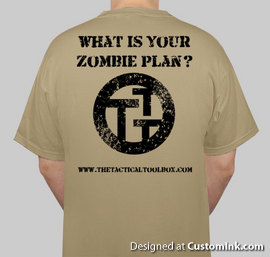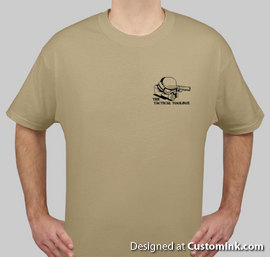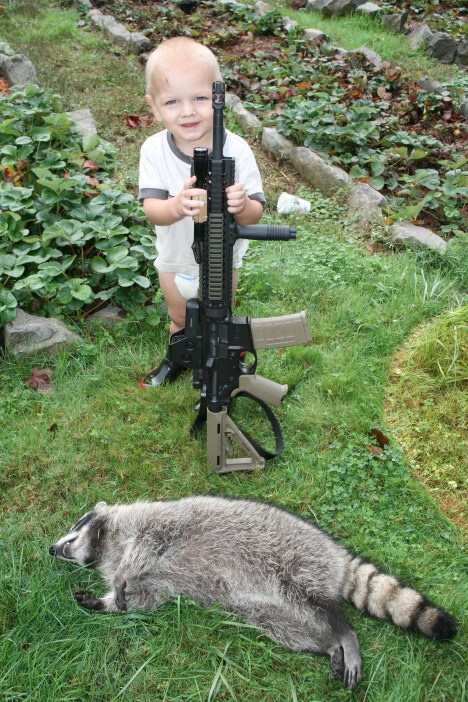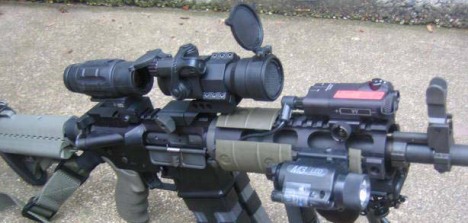Issue #3, December 31, 2009
The Tactical Toolbox Newsletter provides product reviews, training thoughts, political thoughts and anecdotal tidbits about shooting, self-defense and current Toolbox community events.
In this issue:
***Concealed Carry Options: Part 2, On-Body Carry
Evaluating Concealed Carry Options: Part 2
In the first part, we covered the topic of evaluating concealed carry options, first discussing the threshold issues of: handgun size, climate, concessions in clothing/style, comfort vs. effective concealment, and issues related to carry methods. In this second part, we will discuss the different on-body carry options and how they bear on the five threshold issues. Part three will cover off body and special issues.
There are two general styles of carry with many options within each general category. The two general categories are on-body and off-body. On-body is where the handgun is more directly attached to the person, while off body means the handgun is concealed in a purse, fanny pack, backpack, box, etc. The first category we will discuss will be on-body. Links to pictures of each holster type are included in the text.
On Body Carry:
Within the on-body category are holsters that attach to belts/waistbands, shoulder holsters, ankle holsters, thigh holsters, underwear holsters, small of back, and belly band holsters. Below, each type and the subtypes will discussed. Advantages and disadvantages will be discussed in relation to the applicable threshold issues.
1. Belt/waistband holsters:
There are two types of belt/waistband holsters: inside the waistband (IWB) and outside. Each has generally two types of attachment methods available: clip on and belt loop. So that makes for four different general types.
http://www.usgalco.com/ViewLargePic.asp?ProductSKU=RG212
Inside the waistband holsters secure the gun to the belt or clothing waistband with the gun barrel/slide inside the pants. Carry position of inside the waistband holsters typically are strong side, behind the hip of the shooting hand. While this is not universal and there is a growing cadre of shooters preferring to carry the gun up front near the centerline or belt buckle (called appendix carry), most concealed carry by this method is done behind the hip. The stock of the gun is normally situated above the belt line such that the owner can grasp and draw the handgun. Advantages of this method are that the gun barrel does not extend below covering garments (shirts, sweatshirts, coats). This aids greatly in concealment. Larger handguns are harder to conceal using this method, than smaller ones. The most important dimension on the handgun is the grip/stock length as this is what generally gives the most trouble of printing (through the shirt or covering garment). Disadvantages are generally comfort related as the width of the handgun can cause the pants to be very tight (they need to be tight enough to keep the pants up with the gun hanging from them). Overall, this method is good in that the gun is very readily available, and is conducive to a relatively fast draw.
Outside the waistband holsters are generally known as “belt holsters”. While a lot of belt holsters do not cause the handgun to ride high enough or close enough to the body to conceal, they also were generally not designed for concealment purposes. These are more like hunting holsters and will really not be discussed at all here. What will be discussed here are the different types of concealment belt holsters.
There are two types of attachment techniques for the outside the waistband holsters. The first attaches directly to a belt (much preferred is a thick, strong leather belt). The second is known as a paddle holster, so named because there is a paddle that extends down inside the pants and presses against the hip to secure the holster part that extends outside the pants. Generally speaking, paddle types ( http://www.usgalco.com/ViewLargePic.asp?ProductSKU=M4X224 ) are much harder to conceal as they tend to not secure the handgun close enough to the body. Their main use is by police and people who like to be able to take their gun off and put it on quickly throughout the many stages of their day (including bathroom breaks). Advantages are quick setup, excellent retention and solid securing of the gun to the wearer. Disadvantages are that the system is almost impossible to effectively conceal.
The concealment belt holster comes in several types. Mainly there are three types: belt, slide, and pancake. Belt style are very similar to regular belt holsters but are designed for high ride and low profile. A lot of the best concealment belt holsters these days are made of a type of plastic named Kydex. The material is very resistant to wear and allows for the fastest draw due to the securing method of the gun by its trigger guard. A disadvantage to this system is that it must be concealed by a coat or windbreaker and tends to print much easier than IWB style carry. Advantages are comfort and accessibility.
http://www.usgalco.com/ViewLargePic.asp?ProductSKU=M3X212
http://www.usgalco.com/ViewLargePic.asp?ProductSKU=JAK212
http://www.usgalco.com/ViewLargePic.asp?ProductSKU=CON212B
Slide and pancake holsters are very similar in that two pieces of holster material (usually leather or nylon) are sewed together with a non-sewed part left to sandwich the handgun. Belt/slide holsters do not cover the barrel portion of the gun very far while the full pancake holsters pretty much cover the whole gun from just forward of the stock. Both styles cover the trigger (for safety purposes). Both styles keep the gun as close to the body as is possible and work to keep it high enough that some body types can conceal a handgun effectively using an untucked t-shirt or sweatshirt. Advantages of this system are near maximum comfort, good availability/draw speed, and conditionally effective concealment. The main disadvantage of this system is that it can limit your clothing options in order to maintain effective concealment. Most problems will occur with the barrel peeking out from under the coat or sweater.
http://www.usgalco.com/ViewLargePic.asp?ProductSKU=TUC456
One type of holster not mentioned above is the inside the waistband tuckable type whereat the carrier’s shirt can be tucked in around the holster to hide the gun under a tucked in shirt. This type of carry is cumbersome to draw from, but is fairly good for concealing smaller handguns (as well as medium compact sizes like the HK USP Compact and the compact 1911 variants).
2. Shoulder holsters:
http://www.usgalco.com/ViewLargePic.asp?ProductSKU=40RIG
http://www.usgalco.com/ViewLargePic.asp?ProductSKU=VHS212
Shoulder holsters are a cross draw style (meaning the shooting hand reaches across the body to draw the gun) design that secures the gun under the arm and above the belt. The vast majority of shoulder holsters are made of leather. Some of them are made of nylon or a combination of nylon and kydex.
The system of hanging a handgun under the arm is a somewhat problematic concept solved by essentially a figure eight of leather that is worn with an arm through each loop of the eight. The holster hangs either vertically or horizontally (depending upon the type of holster: horizontal or vertical) from the top of the eight, which lies under one arm. Holders for magazines or speed loaders can be built into the other end of the eight under the opposite arm. The crossroads of the eight lands square between the shoulder blades.
This concept works to hide a handgun under the drape of a medium loose fitting coat, including a suit coat or sports jacket. It frees up the beltline of the carrier. Advantages of this system are that it can conceal a smaller handgun very well in circumstances where any kind of waistband type holster would not work, that it is very comfortable, and that the gun can easily be drawn while sitting/riding in a car. The disadvantage of this system is first, that concealment is not always effective when the jacket flies open due to wind or movements of the wearer. Many a gun has been flashed to the unwary public due to the gun butt protruding out while the wearer was bending over. Another disadvantage of the system is slow draw. While the gun is almost universally available, the draw stroke requires the shooter to reach all the way across his body in a very obvious and lengthy motion.
3. Ankle holsters:
http://www.usgalco.com/ViewLargePic.asp?ProductSKU=AG296
Attaching a gun to one’s ankle is also one of those systems requiring the overcoming of body mechanics. It is hard to strap something as dense as a hunk of metal to one’s calf and not have gravity move it down into one’s shoe. But thanks to science, designs exist that can hold a small sized handgun in place. One of the main issues is that the choice of gun is very limited due to the size of the pant leg used to conceal the handgun. The other main issue is slow draw and the position necessary to be assumed to put the hand in contact with the gun. The ankle holster cannot be worn with shorts, etc. and the type of pants are also limited that will work with the system. A lot of police and serious concealed carry persons do use ankle holsters for concealment of their back up gun. Even though the gun is small and the draw is slow, their reasoning is that it is better to have a gun than none at all (in the event their primary is unavailable).
4. Thigh holster:
http://www.usgalco.com/ViewLargePic.asp?ProductSKU=TBBK2
Thigh holsters are for women. The concept is to have a double or single strap around the thigh with the holster attached to these with a garter style tether attached to the waist or belt to keep the whole rig from dropping around the ankle They do work to conceal a small handgun for the women whose thighs don’t already touch each other. There is a limited choice for this type of holster. Obviously, the wardrobe choice would be limited for this carry concept, too. Only dresses or skirts will work, and longer hemlines make the draw even slower or more difficult. Advantages to this type of concealment method are good concealment, effective concealment (as in no one’s supposed to be looking there and no one’s going to discover it while hugging the carrier), works with some of the hardest garments to otherwise conceal a handgun. Disadvantages are that the size of handgun is limited, few choices exist as to holster manufacturers and models, and the gun is slower to draw. One other advantage is not tactically related, but if you are a woman looking to turn on your gun loving romantic interest, a thigh holster is the sexiest rig to use.
5. Small of Back (S.O.B.):
http://www.usgalco.com/ViewLargePic.asp?ProductSKU=SOB212
http://www.usgalco.com/ViewLargePic.asp?ProductSKU=MOB212B
The small of back holster is technically a belt holster in that it attached to a belt, but the method/angle of carry is different enough to warrant a separate discussion. With a SOB holster, the handgun is secured basically inline with the belt such that the muzzle is horizontal. Another form of SOB carry is vertical like an IWB holster, but the position is basically in the small of the back, in between the wearer’s gluteus maximus cheeks. Both require a different draw stroke and conceal somewhat differently than the IWB method. The first major difference is in the accessibility of the handgun while seated. The SOB method is not good for this and can be uncomfortable while sitting for long periods. For some wearers, it really doesn’t seem to hurt them much. The SOB carry is fairly easy to conceal while not bent over. While bending over, if the concealing garment isn’t long enough or heavy enough, the gun will either be fully exposed or print badly. Again, while not sitting, the method is also fairly comfortable, even if the wearer is carrying inside the waistband, generally due to the lack of flesh in the gap between the cheeks.
Generally, there are few advantages to the SOB carry unless the wearer is having issues with IWB or belt holster carry. Some wearers merely just prefer the method. One reason some rather experienced people carry in that method is due to the accessibility of the gun to both right and left hands. The method conceals easily, but is harder to keep concealed while bending over and it is less secure from unwanted users. The draw is slow and can be made fairly inaccessible by the type of seating employed (although IWB and belt holsters become hard to deal with under jackets pinned down by seatbelts, too). Due to the comfort level, the outside the waistband version of this holster can be a popular choice.
6. Belly Band:
http://www.usgalco.com/ViewLargePic.asp?ProductSKU=UWBKLG
The belly band holster is a strip of material that is generally a mesh synthetic which is adjustable using elastic and Velcro. It secures a gun in pockets sewn into the material of the band. This presses the gun fairly tightly/flat against the abdomen or back above the beltline. On men, the belly band can stay fairly secure for all day carry, is comfortable and conceals a smaller handgun well, with larger handguns being concealed fairly effectively. It is designed for hot weather carry under a t-shirt and allows the wearer to wear shorts which would not support a handgun. Downsides of this method are speed of draw and overall security. While it can be fairly fast, is probably not in the class of speed as regular belt holster or IWB. It is very secure in a control sense (the wearer naturally denies people the access of touching him in that area of the abdomen), but the overall method can present problems of the whole band moving around under certain types of movement (running, jogging, wrestling). It depends upon body type. Some people will find it doesn’t work, while others may swear by it.
7. Thunderwear:
http://www.thunderwear.com/images/comfort.jpg
I mention this one by name because it is so unique. This method of carry resembles an athletic supporter, but is not actually secured between the legs. It consists of an adjustable band with a double pocket section in the front made from soft fabric which hangs down from the band. This setup is designed to secure a handgun below the waistline/beltline in the front/crotch. The gun is accessed by either inserting the shooting hand into the pants or using the non-shooting hand to press up on the barrel to cause the grip of the gun to protrude up above the beltline. It doesn’t require any specific form of pants/shorts with a strong belt because it doesn’t rely on the outer garment for support. The method apparently is very effective concealment even though for men, other things are down there, too. Thunderwear type holsters are very versatile and many men as well as women claim it is both comfortable and effectively conceals their handgun. Your esteemed writer has not actually tried one of these and is working from hearsay from other users (as well as universal experience gained from 13 years carrying concealed). Overall, while I am unwilling to say this is the best universal method for carry, there are a lot of good reviews on this.
Downsides to this design are speed of draw, potential comfort issues while sitting down, and potential limitations to the size of handgun permitted. With the butt of the pistol below the beltline of the covering garment, it can be very hard to get a solid grip on the handgun quickly. There may be issues of the barrel jamming itself into sensitive areas or flesh while sitting down. Due to the aforementioned issue, the size of handgun may be limited to something smaller than the prospective carrier wants to use. Upsides are the universality of the design. It fits most garment types as well as most handgun designs.
8. Appendix Carry:
http://www.onesourcetactical.com/index.asp?PageAction=VIEWPROD&ProdID=1970&HS=1
While appendix carry was briefly mentioned in passing above in the IWB section above, this method is also different enough to garner special mention. AIWB (appendix, inside the waistband) is more prominently pushed by such individuals as Gabe Suarez at Suarez International. The history of this type of concealed carry is probably the longest of any type. Considering the garments and generation wearing them now are in near universal ridicule by the more vocal generation, it is understandable that different methods of IWB carry are now the norm. The generation we make fun of because their pants are pulled up under their armpits is the one that used to carry a full sized Government Model Colt 1911 under nothing more than a thin suit coat with no issues of comfort, concealability, or accessibility. The gun could be concealed simply by keeping the jacket buttoned. Because the beltline is so high, it would not restrict bending over (even with five inch barreled handguns). Due to the handgun being right up front, draw would be as unrestricted as possible for a concealed handgun.
Lowering the beltline and changing the wardrobe to less “formal” appearing attire makes this method of carry harder, more uncomfortable and relegates it to either short time periods of carry or to the extremely fit men who have enough time to tone their abs (and probably not even then to all fit men).
Commentary section:
In this day and age whereat old people are nearly universally ridiculed and the young are effectively put on pedestals suitable for worship, it is no wonder that a method of concealed carry which is probably the most superior method (with or without a holster!) ever devised has now fallen into nearly total disuse. The beltlines keep dropping as well as the common sense. Fashions today are just as incompatible with concealed carry as is their suitability for work or productivity. I guess the following generations are going to have to reinvent things and discover that people 100 years ago indeed did know how to carry a gun.
Continued next issue: Part 3 Off-Body Carry Options!
Filed under: Newsletters, Newsletters 2009 | Leave a comment »




 Pictures courtesy of Galco.
Pictures courtesy of Galco.





 Red dot sights such as Aimpoint, EoTech, ProPoint, Fastfire, Trijicon, all have similar features and some dissimilar shortcomings. Their similar features are that they are typically smaller than regular magnifying riflescopes and lighter. They have zero magnification optics which can facilitate the use of flip up iron sights through the visual field of the optics. Almost all of them require batteries. Some fit regular scope caps for water intrusion; others require something special while the Trijicon and Burris Fastfire don’t seem to have any caps to seal out water.
Red dot sights such as Aimpoint, EoTech, ProPoint, Fastfire, Trijicon, all have similar features and some dissimilar shortcomings. Their similar features are that they are typically smaller than regular magnifying riflescopes and lighter. They have zero magnification optics which can facilitate the use of flip up iron sights through the visual field of the optics. Almost all of them require batteries. Some fit regular scope caps for water intrusion; others require something special while the Trijicon and Burris Fastfire don’t seem to have any caps to seal out water.
